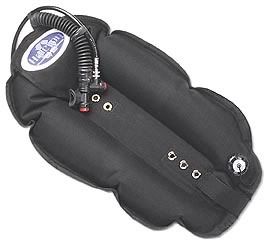spschneer:
Oh, by the way, Tobin...Which DSS wing
is comparable to the Oxycheq Mach V after all

???
Steve
(even tho' I promise to just look at 17/20 lbs lift and will be only using 5-6 lbs of weight for the rest of my diving career)

:11:


Shawn,
Let's take a look at wing design in general. Water is ~63 lbs / cuft. That means if you want 30 lbs of lift you need to displace 30/63 = .476 cuft or about 823 cu inches.
Any 30 lbs wing will need to displace this volume. The trick becomes how to do so in a shape that is streamlined and easy venting.
Prior to the introduction of the DeepSeaSupply LCD 30 wing in 2004, single tank wings featured wide center panels, often 6-8 inches wide. The LCD 30 was the first to feature a narrow center panel, ~3 inches wide.
The DSS LCD 30 was the first wing to use the space between the tank and plate for inflation. Result is a much narrower wing profile, and a wing that vents easily when the diver is horizontal because there is very little tank wrap.
There are substantial benefits in moving from a 6-7 inch wide center panel to a 3 inch wide center panel because there is a lot of previously "unused" volume, in the roughly triangular space between the side of the tank and plate. Center panels narrower than 3 inches make use of almost no additional "unused volume" and do not allow wings to be measurably smaller in cross section.
This fundamental advance in wing design, the narrow center panel, has been more recently adopted by other wing companies.
I would respectfully suggest your question is worded in reverse.
All DSS wings are very narrow designs, as streamlined for a given volume as the physics allows.
If you want the least possible drag, use the smallest lift narrow center panel wing that safely meets the requirements of your application.
Tobin
 ???
??? :11:
:11:








